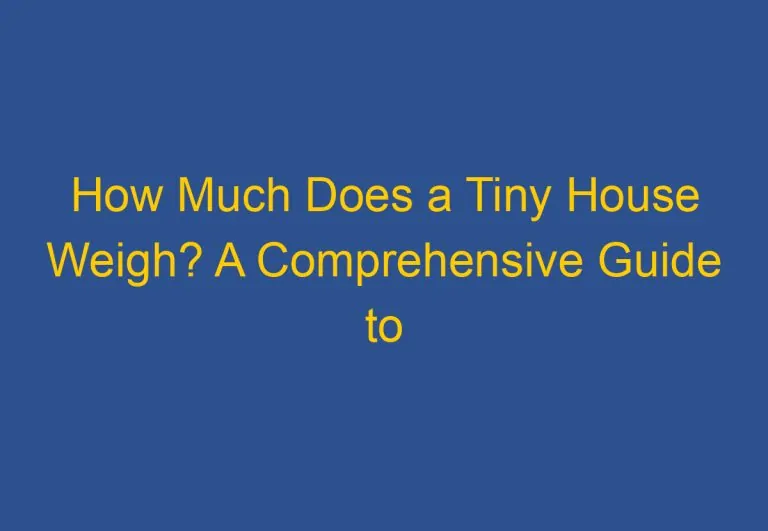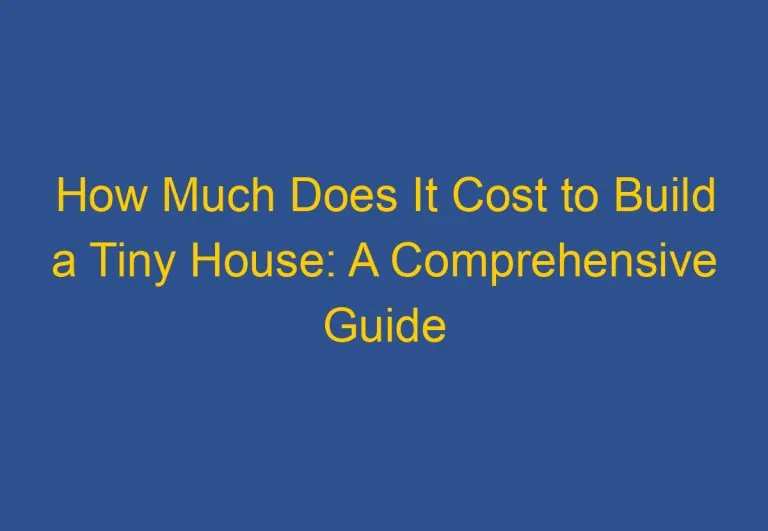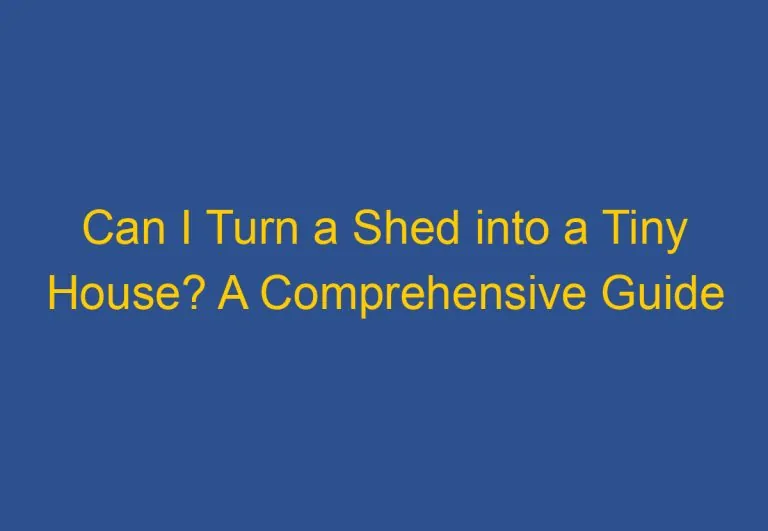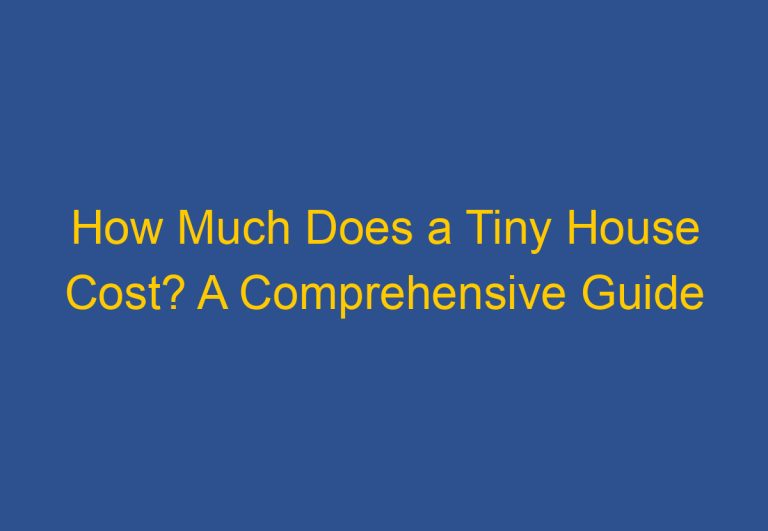Are Tiny Houses Legal in NY? A Comprehensive Guide to Tiny House Laws in New York State
Tiny houses have become increasingly popular in recent years as a way to live more simply and sustainably. However, if you’re considering building or living in a tiny house in New York, you may be wondering if they are legal in the state. The answer is not a simple yes or no, as the legality of tiny houses in New York depends on various factors, including location, zoning regulations, and building codes.
New York has adopted Appendix Q, which provides building guidelines for tiny houses. However, it’s important to note that zoning regulations vary across different cities, towns, and villages in the state. Reviewing local zoning and land use regulations is essential to determine the legality of building and living in a tiny house in your location. Additionally, the 2020 Residential Code of New York State includes the adoption of Appendix Q titled “Tiny Houses,” which defines a tiny house as “a dwelling that is 400 square feet (37 m2) or less in floor area excluding lofts.”
If you’re considering building or living in a tiny house in New York, it’s important to do your research and understand the laws and regulations surrounding tiny houses in the state. This article will provide an overview of the current legal landscape for tiny houses in New York, including information on zoning regulations, building codes, and other factors that may impact the legality of tiny houses in the state.
Legality and Zoning Regulations
New York State Laws
Tiny houses are becoming increasingly popular in New York, but their legality is subject to zoning regulations and building codes. Understanding the laws and regulations surrounding tiny homes in New York is essential for compliance and avoiding legal issues. The state has adopted Appendix Q, which provides building guidelines for tiny houses. However, it’s important to note that zoning regulations vary across different cities, towns, and villages in the state.
Local Zoning and Building Codes
Both local zoning laws and the Uniform Code apply to tiny houses. Zoning laws typically include the number and size of dwelling units which may be located on a lot, the distance to the property lines, and the minimum square footage requirements. In addition, building codes dictate the materials, design, and construction methods that must be used to ensure safety and compliance. Homeowners must obtain the necessary permits and inspections from their local zoning department and comply with all local building codes and zoning ordinances.
Tiny Houses on Wheels vs. Permanent Structures
Tiny houses on wheels are typically classified as RVs and are subject to different regulations than permanent structures. While they offer greater flexibility and mobility, they may face challenges when it comes to parking and zoning regulations. Tiny home communities may offer a solution for those looking to park their tiny homes on a more permanent basis, but they may also be subject to additional zoning regulations and property taxes.
In summary, while tiny houses are not explicitly illegal in New York State, homeowners must comply with all relevant zoning and building codes to ensure compliance and avoid legal issues. It’s important to research and understand the specific regulations in your municipality and obtain the necessary permits and inspections before beginning construction.
Design and Construction Standards
Building Code Requirements
When it comes to building a tiny home in New York, it is important to adhere to the state’s building codes. The International Code Council (ICC) has adopted building codes that provide guidelines for the size and dimensions of habitable spaces within a tiny house. According to these codes, habitable rooms such as bedrooms and living spaces must have a minimum length and width of at least 7 feet. Tiny homes must also meet some size requirements, with a minimum square footage of 400 square feet and a maximum of 1500 square feet.
Utilities and Infrastructure
Tiny homes in New York must have access to utilities and infrastructure, including plumbing, electricity, and waste management. Builders must ensure that their tiny homes are structurally sound and safe to live in. They must also provide adequate ventilation and insulation to ensure that the home is comfortable and energy-efficient.
Certifications and Inspections
Builders of tiny homes in New York must obtain the necessary certifications and inspections to ensure that their homes meet all relevant building codes and safety standards. Appendix Q of the 2020 Residential Code of New York State provides specific guidelines for tiny houses on wheels. Additionally, tiny homes may be classified as Accessory Dwelling Units (ADUs) and subject to additional regulations. It is important for builders to research and comply with all relevant regulations to avoid fines or legal issues.
In summary, designing and constructing a tiny home in New York requires adherence to building codes, access to utilities and infrastructure, and obtaining necessary certifications and inspections. Builders must ensure that their tiny homes are safe, structurally sound, and energy-efficient. By following these guidelines, individuals can enjoy the benefits of a minimalist lifestyle while complying with all relevant regulations.
Frequently Asked Questions
What regulations govern the construction of tiny houses in New York State?
New York State has adopted the International Code Council Building Codes, which provide guidelines for the size and dimensions of habitable spaces within a tiny house. According to these codes, habitable rooms, such as bedrooms and living spaces, must have a minimum length and width of at least 7 feet. Additionally, the minimum ceiling height in a hallway and occupiable space in a tiny house is not less than 2032 mm (6 feet 8 inches).
Do zoning laws in New York permit the establishment of tiny house communities?
Zoning regulations for tiny houses in New York State vary by municipality. In some areas, tiny houses are allowed as long as they meet certain requirements, such as minimum square footage and being built on a foundation. However, in other areas, zoning laws may prohibit the establishment of tiny house communities altogether.
Are there specific areas in New York where tiny house construction is more permissible?
There are no specific areas in New York where tiny house construction is more permissible. Zoning regulations for tiny houses in New York State vary by municipality and are subject to change.
What are the minimum size requirements for legally inhabitable dwellings in New York?
According to the International Code Council Building Codes adopted by New York State, habitable rooms, such as bedrooms and living spaces, must have a minimum length and width of at least 7 feet. Additionally, a dwelling that is 400 square feet (37 m2) or less in floor area excluding lofts is considered a tiny house.
What permits are required to build a tiny house in New York?
Permits required to build a tiny house in New York vary by municipality. It is recommended to consult with local building officials to determine the necessary permits for your specific project.
How does Appendix Q affect tiny house building codes in New York?
The 2020 Residential Code of New York State includes the adoption of Appendix Q titled “Tiny Houses.” Appendix Q, applicable to tiny houses used as single dwelling units, defines a tiny house as “a dwelling that is 400 square feet (37 m2) or less in floor area excluding lofts.” Appendix Q provides specific guidelines for the construction of tiny houses, including loft height and ladder requirements. It is important to note that Appendix Q is not mandatory and is subject to adoption by individual municipalities.










